
3 minute read
What’s In An Attachment And Why Should You Care?
I wanted to write a ‘What forklift attachment are you?’ article, something similar to those clickbait stories that try to figure out what celebrity you most likely identify as by answering a few mundane personality questions.
attachments may be required to be fitted by an appropriately qualified person. All forklifts must display a data plate revising the rated capacity of the machine, taking into account any attachments fitted when applicable.
When an attachment is fitted to a forklift, its operating characteristics may change, making it necessary to de-rate the forklift capacity and restrict some operating controls. Attachments must have rated capacities matched to the appropriate classification and capacity of the forklift.
you? It’s important to know what your forklift and its attachments are rated to. Just as important are the safety systems implemented when operating such machinery, so as not to injure yourself or others.
Safety systems may be installed at the time of forklift procurement or retrofitted to an existing fleet. Safety systems fall into two categories - passive and active safety systems.
Rodney Grant Chief Executive NZFIA

But that might be a little inappropriate for this platform. Instead, let’s dive into the vast selection of attachments available to be mounted on forklifts and why it is important to be cognisant of each design’s intended purpose.
Each attachment is designed to handle specific materials and reduce the likelihood of causing damage to loads and increase safety and productivity.
The Forklift Good Practice Guidelines has a list, that is by no means exhaustive, but gives readers an idea of the vast majority of attachments available to the industry that either fall within, or are a modification to, nine categories:
• Forks
• Clamps
• Jib attachment
• Push-pull
• Side shift
• Rotators
• Pole attachments
• Trailer push attachment
• Forklift-mounted safety platforms

All attachments must be rated and display this information clearly. Once fitted, attachments become part of the forklift and must be included in the pre-operational inspection. Some
I won’t bore you with the minute details of every category but let’s, at least, talk about the most common – the forks. Often referred to as tynes, the forks of a forklift vary in length, width, thickness, mounting type, tensile strength and profile.
The forklift-rated capacity, load centre, carriage design and role will help determine the correct fork type for a particular machine.
Some fork attachments allow multiple sets of forks to be mounted. Twin and multifork attachments are often fitted with side shift functionality and allow the forklift to handle larger loads, as well as multiple pallets and one time.

Additionally, there are fork extensions that are designed for the occasional use but should not be a permanent substitute for appropriately sized forks. While extensions can increase a forklift’s load centre, by allowing loads to be placed further away from the fulcrum, they cannot carry heavier loads and do not increase the rated capacity of the forklift.
Why am I sharing this with
The wide scope of roles, environments and settings in which forklifts operate determines what safety systems are required. A risk assessment focusing on the role, environment and settings in which the forklift operates will help identify the most appropriate system(s) to fit to the forklift.
Consideration should also be given to integration with any systems that may already be on-site, as well as the level (if any) of modification that will be required.
Systems may be mounted to the forklift, other vehicles, static structures and objects, or worn by pedestrians.
Passive safety systems reduce the chance of serious injury or death in instances is an accident occurs, and can include things like seatbelts, collision measuring devices and alarms, rollover protection structures and speed governors.
An active safety system is slightly different; simply put, they avoid or mitigate an accident pre-impact – so before it happens or contact is made.
Lighting is one (that could include a strobe or the rotating variety), cameras are another and even mirrors.
This may seem all like common sense to the highly trained and competent operator. But due to the complexity of supply chain operations, vehicle traffic in warehouses and factory floors has increased significantly, causing a major risk of forklift-related accidents.
So, it pays to know your stuff and look out for your workmates. n










